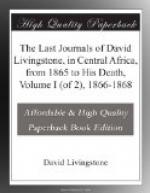7th May, 1866.—We are now opposite a mountain called Nabungala, which resembles from the north-east an elephant lying down. Another camel, a very good one, died on the way: its shiverings and convulsions are not at all like what we observed in horses and oxen killed by tsetse, but such may lie the cause, however. The only symptom pointing to the tsetse is the arterial-looking blood, but we never saw it ooze from the skin after the bite of the gad-fly as we do now.
8th May, 1866.—We arrived at a village called Jponde, or Liponde, which lies opposite a granitic hill on the other-side of the river (where we spent a night on our boat trip), called Nakapuri; this is rather odd, for the words are not Makonde but Sichuana, and signify goat’s horn, from the projections jutting out from the rest of the mass. I left the havildar, sepoys, and Nassick boys here in order to make a forced march forward, where no food is to be had, and send either to the south or westwards for supplies, so that after they have rested the animals and themselves five days they may come. One mule is very ill; one buffalo drowsy and exhausted; one camel a mere skeleton from bad sores; and another has an enormous hole at the point of the pelvis, which sticks out at the side. I suspect that this was made maliciously, for he came from the field bleeding profusely; no tree would have perforated a round hole in this way. I take all the goods and leave only the sepoys’ luggage, which is enough for all the animals now.
9th May, 1866.—I went on with the Johanna men and twenty-four carriers, for it was a pleasure to get away from the sepoys and Nassick boys; the two combined to overload the animals. I told them repeatedly that they would kill them, but no sooner had I adjusted the burdens and turned my back than they put on all their things. It was however such continual vexation to contend with the sneaking spirit, that I gave up annoying myself by seeing matters, though I felt certain that the animals would all be killed. We did at least eight miles pleasantly well, and slept at Moedaa village. The rocks are still syenite. We passed a valley with the large thorny acacias of which canoes are often made, and a euphorbiaceous tree, with seed-vessels as large




